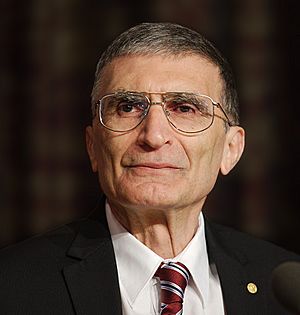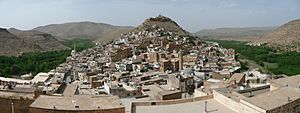Aziz Sancar facts for kids
Quick facts for kids
Aziz Sancar
|
|
|---|---|

Sancar in 2015
|
|
| Born | 8 September 1946 Savur, Mardin, Turkey
|
| Citizenship | Turkey, United States |
| Education |
|
| Spouse(s) |
Gwen Sancar
(m. 1978) |
| Awards |
|
| Scientific career | |
| Fields |
|
| Institutions |
|
| Thesis | A study on photoreactivating enzyme (DNA photolyase) of Escherichia coli (1977) |
| Doctoral advisor | Claud Stan Rupert |
Aziz Sancar (born September 8, 1946) is a Turkish molecular biologist. He studies how DNA (our body's instruction manual) gets fixed when it's damaged. He also researches how our bodies keep time, like our sleep-wake cycles.
In 2015, he won the Nobel Prize in Chemistry. He shared this award with two other scientists, Tomas Lindahl and Paul L. Modrich. They were recognized for their important discoveries about how DNA repair works. Sancar's work on special enzymes called photolyase and nucleotide excision repair in bacteria changed how scientists understood this field.
Today, Professor Sancar teaches at the University of North Carolina School of Medicine. He is also part of the UNC Lineberger Comprehensive Cancer Center. He helped start the Aziz & Gwen Sancar Foundation. This group helps share Turkish culture and supports Turkish students in the United States.
Contents
Early Life and Education
Aziz Sancar was born in a small town called Savur in southeastern Turkey. He was born on September 8, 1946. He was the seventh of eight children in his family.
His parents did not go to school themselves. However, they believed strongly in the power of education. They made sure all their children had a chance to learn. Aziz was taught by inspiring teachers who encouraged him.
He was a very good student throughout his school years. He first wanted to study chemistry in high school. But he decided to study medicine instead, like some of his friends. He earned his medical degree from Istanbul University in Turkey in 1969. He was the top student in his class.
University Studies
After medical school, Sancar worked as a doctor in his home region for about 1.5 years. He then received a scholarship to study biochemistry in the United States. He learned English while studying there.
He later earned his PhD in 1977 from The University of Texas at Dallas. His research focused on how a special enzyme, called photolyase, helps repair DNA in bacteria.
Discoveries in DNA Repair
After getting his PhD, Sancar worked at Yale University for five years. This is where he began his groundbreaking work on DNA repair. He studied a process called nucleotide excision repair. This process fixes DNA damage even without light.
He discovered how certain enzymes, like UvrABC endonuclease, find and cut out damaged parts of DNA. These enzymes remove a small section of 12-13 building blocks of DNA. This allows the cell to replace the damaged part with healthy DNA.
Later, Sancar became a professor at the University of North Carolina. He continued his research there. He studied how this same repair process works in humans, which is more complex than in bacteria.
His long-term research also focused on photolyase. This enzyme uses light to fix DNA damage caused by ultraviolet (UV) rays. His work helped scientists understand exactly how this light-powered repair happens.
In 2005, Aziz Sancar was chosen to be a member of the National Academy of Sciences. This is a very high honor for scientists in the United States. He is a professor of Biochemistry at the University of North Carolina at Chapel Hill.
He is married to Gwen Boles Sancar, who is also a biochemistry professor. Together, they created Carolina Türk Evi. This center helps Turkish students and scholars in the U.S. and promotes cultural exchange.
Research on Circadian Clock
Sancar and his team have also made important discoveries about the circadian clock. This is our body's natural 24-hour rhythm. They found that two genes, called Period and Cryptochrome, help keep our body clocks in sync. These clocks control many things, like when we sleep and wake up.
Their findings were published in 2014. Understanding the circadian clock can help treat problems like jet-lag or seasonal affective disorder. It might also help doctors plan cancer treatments at the best time for a patient's body.
Personal Life
Aziz Sancar met his wife, Gwen Boles Sancar, while they were both studying molecular biology in Dallas. They got married in 1978.
Sancar identifies as a Muslim. He has stated that he is proud of his Turkish identity. His brother, Tahir, mentioned that their family comes from Oghuz Turks from Central Asia.
Awards and Recognition
Aziz Sancar received the 2015 Nobel Prize in Chemistry. He shared it with Tomas Lindahl and Paul L. Modrich for their work on DNA repair. He also received the Presidential Young Investigator Award in 1984.
Sancar is the second Turkish person to win a Nobel Prize. The first was Orhan Pamuk, a writer.
On May 19, 2016, Aziz Sancar gave his original Nobel Prize medal and certificate to the Anıtkabir. This is the mausoleum of Mustafa Kemal Atatürk, the founder of modern Turkey. He also gave a copy of his medal to Istanbul University, where he earned his medical degree.
In January 2025, Sancar received the Order of Cultural Ambassador of the Turkic World. This award was given by TÜRKSOY, an international organization that promotes Turkic culture.
See also
 In Spanish: Aziz Sancar para niños
In Spanish: Aziz Sancar para niños




